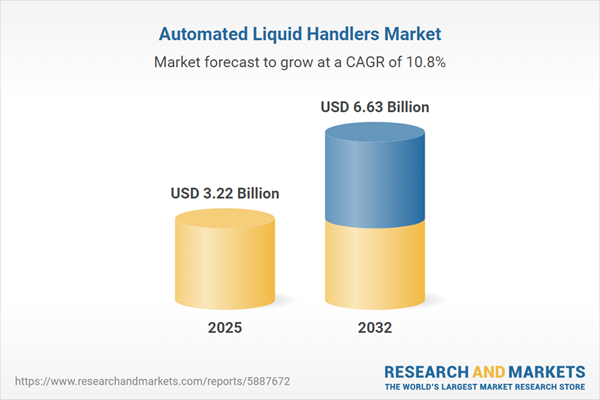Speak directly to the analyst to clarify any post sales queries you may have.
The automated liquid handlers market is transforming laboratory operations worldwide, equipping organizations to achieve standardized workflows, higher throughput, and process innovation. Decision-makers seeking to enhance productivity and ensure regulatory compliance are increasingly prioritizing this critical automation technology for diversified research and diagnostics environments.
Market Snapshot: Automated Liquid Handlers Market Growth and Trends
The Automated Liquid Handlers Market grew from USD 2.90 billion in 2024 to USD 3.22 billion in 2025. It is expected to continue growing at a CAGR of 10.84%, reaching USD 6.63 billion by 2032. This trajectory reflects accelerating deployment across both large and mid-sized laboratory settings, fuelled by demand for reliable, scalable automation. Laboratories across biopharmaceutical, academic, and clinical research segments are institutionalizing automated liquid handling systems to drive not only process consistency but also operational efficiency. The market’s momentum aligns with advancements in technology, as well as broader trends in life sciences and process digitalization.
Scope & Segmentation
- Product Types: Dispensers (including peristaltic, piezoelectric, and solenoid valve variants), syringe systems, pipetting platforms (acoustic, air displacement, positive displacement), tip eject mechanisms (adapter and nozzle eject), and washer modules (for microplate and tube formats).
- End Users: Academic research centers, biotechnology organizations, clinical diagnostics labs, food and beverage quality control, and pharmaceutical development facilities.
- Applications: Drug discovery, genomics workflows (PCR and sequencing), high throughput screening, and proteomics research.
- Technologies: Acoustic dispensing, air displacement, positive displacement.
- Regions: Americas (North America, Latin America), Europe, Middle East & Africa, and Asia-Pacific.
- Regional Markets: United States, Canada, Mexico, Brazil, Argentina, Chile, Colombia, Peru, United Kingdom, Germany, France, Russia, Italy, Spain, Netherlands, Sweden, Poland, Switzerland, United Arab Emirates, Saudi Arabia, Qatar, Turkey, Israel, South Africa, Nigeria, Egypt, Kenya, China, India, Japan, Australia, South Korea, Indonesia, Thailand, Malaysia, Singapore, Taiwan.
- Leading Companies: Thermo Fisher Scientific Inc., Danaher Corporation, Agilent Technologies, Inc., PerkinElmer, Inc., Tecan Group Ltd., Hamilton Company, Eppendorf AG, Gilson, Inc., SPT Labtech Ltd., Qiagen N.V.
Key Takeaways for Senior Decision-Makers
- Automated liquid handling platforms are fundamental in driving precision and consistency, especially in high-throughput and complex laboratory environments.
- Sophisticated integration with laboratory information management systems enables real-time analytics, improving resource allocation and supporting faster, more accurate research outcomes.
- Advancements such as acoustic dispensing and adaptive software algorithms expand applicability, accommodate smaller volumes, and minimize human intervention.
- Modular designs facilitate incremental platform upgrades, aligning with evolving research needs and future scalability without necessitating major infrastructure investments.
- End users benefit from tailored post-sales service, including rapid maintenance response and specialized application support, fostering long-term operational reliability.
- Collaboration among instrument manufacturers, software developers, and genomics providers is resulting in turnkey solutions that accelerate deployment and maximize automation ROI.
Tariff Impact: U.S. Tariff Adjustments Shaping Supply Chains
Revised U.S. tariff regulations in 2025 reshaped automated liquid handling equipment supply chains. Increased import duties on critical components prompted procurement teams to consider total cost of ownership and seek longer-term maintenance agreements. Manufacturers responded by expanding assembly operations closer to key markets, accelerating delivery timelines and reducing tariff exposure. Some suppliers established partnerships for domestic module manufacturing, strengthening resilience against fluctuating trade dynamics. Innovative leasing and subscription models are also emerging to provide laboratories access to leading technology with manageable, predictable costs.
Methodology & Data Sources
This report utilizes a layered research approach, integrating primary interviews with laboratory and procurement leaders, extensive secondary analysis of scientific publications and industry briefings, and observational site visits that validate automation workflows. Trends in throughput and maintenance were further illuminated by anonymized operational data, and findings were cross-verified by subject matter experts to ensure accuracy and actionable insight.
Why This Report Matters
- Enables executive teams to anticipate and plan for disruptive operational or regulatory shifts impacting laboratory automation investments.
- Equips organizations to benchmark against peer adoption patterns and segment-specific demands, strengthening competitive positioning.
- Supports informed capital allocation by connecting technology trends, segmentation drivers, and regional growth opportunities to practical procurement strategies.
Conclusion
Automated liquid handlers are redefining laboratory standards for accuracy and scalability. Senior leaders leveraging this report gain a strategic view of evolving technology, regulatory, and supply chain drivers shaping the market’s next chapter.
Additional Product Information:
- Purchase of this report includes 1 year online access with quarterly updates.
- This report can be updated on request. Please contact our Customer Experience team using the Ask a Question widget on our website.
Table of Contents
3. Executive Summary
4. Market Overview
7. Cumulative Impact of Artificial Intelligence 2025
Companies Mentioned
The companies profiled in this Automated Liquid Handlers market report include:- Thermo Fisher Scientific Inc.
- Danaher Corporation
- Agilent Technologies, Inc.
- PerkinElmer, Inc.
- Tecan Group Ltd.
- Hamilton Company
- Eppendorf AG
- Gilson, Inc.
- SPT Labtech Ltd.
- Qiagen N.V.
Table Information
| Report Attribute | Details |
|---|---|
| No. of Pages | 182 |
| Published | October 2025 |
| Forecast Period | 2025 - 2032 |
| Estimated Market Value ( USD | $ 3.22 Billion |
| Forecasted Market Value ( USD | $ 6.63 Billion |
| Compound Annual Growth Rate | 10.8% |
| Regions Covered | Global |
| No. of Companies Mentioned | 11 |









